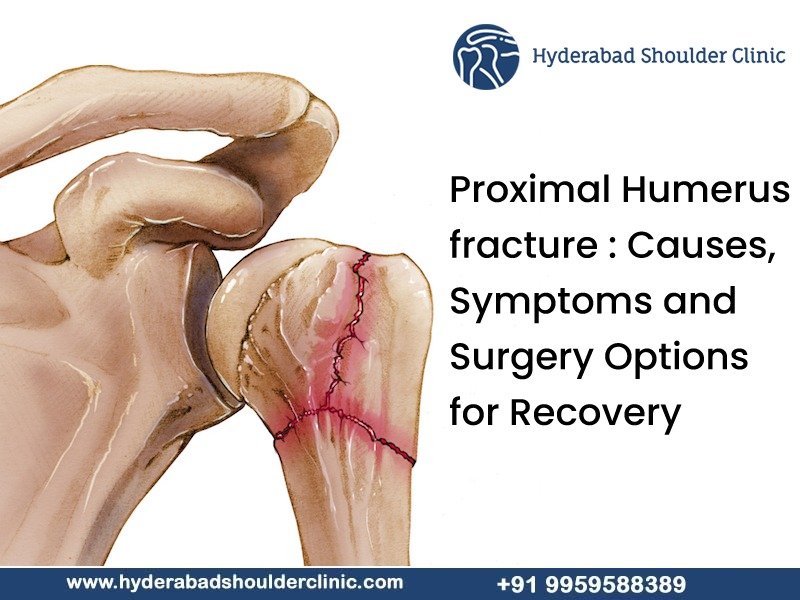The humerus is the upper arm bone that runs from the shoulder and scapula (shoulder blade) to the elbow. Humerus fractures can either occur at the proximal region or the shaft region. A proximal humerus fracture means the fracture occurred close to the shoulder joint. There are two fracture patterns namely, simple or comminuted. When this fracture occurs, the patient experiences pain, swelling, and a reduced range of motion. This fracture could further cause axillary nerve or axillary artery injury.
The cause of proximal humerus fracture is generally a fall onto the arm or direct trauma to the arm. An expert shoulder surgeon will diagnose the fracture with the aid of X-rays or a CT scan.
A non-surgical treatment is suggested where the patient’s arm movements are arrested with a sling for a brief period, followed by specific exercises. However, if the fragments are separated commonly, surgery is recommended. However, surgical intervention is rare in the case of proximal humerus fracture.
Proximal humerus fractures are common in elders, too. In this age group, they are the third most common fractures. The first two are hip and Colles fractures. Surprisingly, women get proximal humerus fractures more than men.
Signs and symptoms of proximal humerus fracture
Typical signs and symptoms include
- Pain
- Swelling
- Bruising
- Limited range of motion at the shoulder.
- If the fracture is severe, then arm deformity occurs, and it is visible that something is not right.
- If the patient complains of numbness over the outside part of the upper arm and deltoid muscle weakness, it means the axillary nerve has been injured.
- A grinding sensation during shoulder movements
- Bleeding in case of open fractures
Causes of proximal humerus fracture
The cause of proximal humerus fracture is mostly physical such as:
- In younger people, the chance of this fracture is after a significant trauma to the arm, like a motor vehicle collision.
- A trauma to the outstretched hand, a car crash, or some other type of accident.
- In elders, proximal humerus fracture occurs due to a fall from standing height.
Risk factors of proximal humerus fracture
- People in professions where they are constantly working at heights, like construction workers, painters, etc.
- Osteoporosis is a major risk of proximal humerus fractures, which is common in the elderly population.
- Diabetics also are more susceptible to these fractures.
- Young adults and kids who are constantly active and jumping around are susceptible to falls and fractures.
- Physical abuse
Diagnosis of proximal humerus fracture
Shoulder surgeons will get an x-ray of the anterior-posterior view of the shoulder, a lateral (Y or outlet) view, and an axillary view. A velpeau view is an alternative for those who are unable to position the shoulder for an appropriate image. For the velpeau view, the patient is asked to lean backwards 45 degrees while an X-ray beam is aimed toward the floor.
A CT scan of the injured shoulder can help further characterize the fracture and determine articular involvement. If an axillary view is unattainable, a CT scan is also an option.
MRI is only recommended if the surgeon suspects an injury to soft tissue structures such as the rotator cuff muscles.
Treatment of proximal humerus fractures
There are both non-surgical and surgical options for treating proximal humerus fractures. The recommended treatment is decided based on fracture stability, as determined with imaging and clinical exams.
Non-surgical treatment of proximal humerus fractures
Most proximal humerus fractures do not cause fragmentation, as they are stable, so they are treated with conservative treatments. The first step is shoulder immobilization with a sling. Expert shoulder surgeon Dr Chandra Sekhar B will do a close follow-up and weekly x-rays. He will carefully monitor your progress for healing and good alignment.
After the pain subsides, a passive range of motion exercises should be done. A physical therapist will work closely with you and guide you through the weekly exercise regime that you should follow.
Under the expert care of Dr.Chandra Sekhar B, non-surgical treatment options for proximal humerus fractures have given good outcomes in terms of fracture healing and restoration of arm function.
Surgical treatment of proximal humerus fractures
If the trauma has destabilized the shoulder, then the surgeon will opt for surgery. During the surgery, the surgeon will fix the fractured fragments with plates, screws, or pins. The types of surgeries done for proximal humerus fractures are:
- Closed reduction with percutaneous pinning (CRPP)
- Open reduction with internal fixation (ORIF)
- Intramedullary rod fixation
- Shoulder arthroplasty
- Reverse shoulder arthroplasty
Suppose Proximal humerus fractures have occurred in a child. In that case, they respond well to nonoperative treatment due to the large amount of bone growth that occurs at the proximal humerus region.
Recovery from surgery for proximal humerus fracture
Immediately following surgery, mobilization with physical therapy is begun.
Physical therapy focuses on restoring muscle strength, joint motion, and flexibility. The patient is advised to take a break from work, especially if it involves hard labour with hands. Exercises to improve motion and strength should be done daily. Physical therapy is given until the muscles, ligaments, and other soft tissues perform normally.
The exercises are different for nonoperative treatment since the patient has no splints or cast.
If a surgery has taken place, elbow exercises may be started immediately after surgery. After a few weeks shoulder exercises are started.
Dr.Chandra Sekhar B has decades of experience handling cases of proximal humerus fracture. For more information, please visit our website https://hyderabadshoulderclinic.com/ or contact us at +91 9959588389 or shoulderandsportsclinic@gmail.com.





